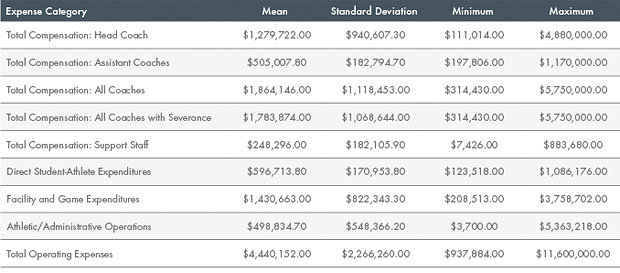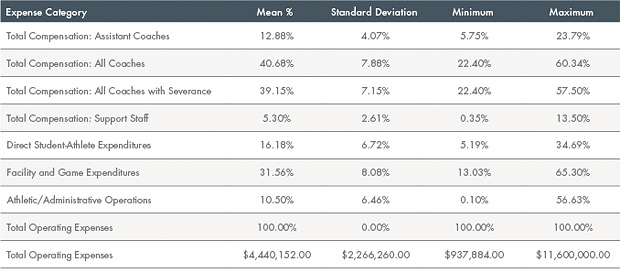Part Two of a four-part, fiscal efficiencies series:
- (Part One: Football Expenditures)
- (Part Three: Fiscal Trends and Measures)
- (Part Four: Revenue, Expenditure, and ROI)
Building on the previously released study on the FBS football expenditures, this article considers the impact of financial decisions in basketball programs. The unique nature of collegiate basketball recruiting and professional eligibility requirements makes the understanding of both athletic and academic outcomes increasingly imperative, especially considering the segment of athletes who remain with their basketball program for a single year. Understanding the interplay between the two largest collegiate programs (men’s football and basketball) is an important consideration for both athletic administrators and university leaders. This study examined three central priorities:
1. Conduct a systematic review of the financial efficiencies of men’s basketball programs while estimating the potential returns on (a) academic and (b) athletic outcomes.
2. Utilize a multilevel model not only to estimate the schoollevel impact of men’s basketball expenditure, but also to examine the potential effects of conference alignment.
3. Discuss the existence of possible trade-off in terms of resource allocation strategies to inform athletic administrators as they make decisions within the current economic climate.
Overarching results in this study indicate the following:
1. Trade-off exists between increasing academic progress rate (APR) and rating percentage index (RPI) scores based on various line-item expenditures.
2. Recruiting expenses appear to possess the biggest tradeoff as the reallocation of 1% of recruiting funds to other expense areas would have substantial positive impact on APR but a significant negative impact on RPI.
3. Men’s basketball head coaches (in terms of their salary as a measure of quality) play a significant role in increasing a team’s APR score.
Table 1 provides a foundational understanding of the expenses related to the macro-financial categories of men’s basketball programs. Table 2 provides information on the percentage breakdown of a program’s budget. The use of percentages allows for an understanding of how money is distributed within a program’s budget, while actual dollars provides insight into the disparity that exists within the men’s basketball landscape.
Table 1 — Men’s Basketball Expenditures for Programs in FBS Conferences: Descriptive Statistics in Actual Dollars

Table 2 — Men’s Basketball Expenditures for Programs in FBS Conferences: Descriptive Statistics in Percent of Total Expenditures

Definitions
1. Total Compensation: All Coaches – includes all expenditures (direct or third party) paid to both head and assistant coaches along with severance packages.
2. Direct Student-Athlete Expenditures – includes athletic student aid; equipment, uniforms, and supplies; medical expenses and medical insurance; and recruiting expenses.
3. Facility and Game Expenditures – includes direct facilities, maintenance, and rental; game expenses; guarantees; indirect facility and administrative support; and team travel.
4. Athletic/Administrative Operations – includes fundraising, marketing, and promotions; membership and dues; support and administrative compensation; and other expenses.
s all expenditures (direct or third party) paid to both Methodological Approach
In order to maintain the ability to compare the previous study on FBS football expenditures, this study employed a similar quantitative methodology and limited the men’s basketball samples to men’s basketball programs within Division 1-A or FBS conference affiliation. The exclusion of Division 1-AA or FCS programs was purposeful to ensure that comparisons across programs took into consideration the inherent differences in athletic budgets and comparative environments. Even though some FCS/Division 1-AA programs are provided access to the annual men’s basketball tournament, their level of involvement is limited and would provide skewed estimates of the financial impact. The use of advanced economic and multilevel models allows for this study to ensure factors associated with both conference alignment and BCS eligibility are controlled for in the estimates. Finally, the use of the two years of data (2009 and 2010) is a function of data access and limitations to the sport-specific data. 1
Outcome Measures
This study uses two distinct outcomes to measure potential returns on investment. The academic outcome is measured through the APR developed and used by the NCAA. The APR metric has far-reaching consequences within the NCAA and is a measure of student-athlete educational gains. The athletic outcome is measured through the use of the RPI. The RPI takes into consideration a team’s success on the court along with the strength of its schedule. The use of the RPI as the athletic outcome allows the estimates within this study to be compared with a nationally accepted and validated measure of athletic quality.
Results: Potential Returns on Athletic and Academic Outcomes
Overall Athletic Expenditures
An interesting effect emerged when examining the total men’s basketball budget and its relations to the APR and RPI outcomes. On a macro-level and controlling for conference affiliation and institutional characteristics, total men’s basketball expenditures has a significant and positive impact (albeit small in size) on a team’s APR while having a significant and negative impact on a team’s RPI—meaning that for every additional $10,000 spent on men’s basketball programs, there existed a predicted increase in a team’s APR of 0.50 points. Also, for every additional $10,000 spent on men’s basketball programs, there was a decrease in the team’s RPI ranking of 0.12. Unlike within the prior football analysis, men’s basketball did not appear to possess the same quadratic relationship in total athletic expenditure. The model’s estimates do not statistically identify a point in which total program expenditure would actually change the directional impact. Given that these findings are contrary to the popular notion that expenditures will positively impact athletic and negatively impact academic outcomes, a more detailed examination is needed.
Athletic Outcome – RPI: In looking at the macro-level financial expenditure categories, a school’s percentage of expenditures on coaches’ compensation did not have a significant effect on the RPI outcome. However, the percent of the budget spent on Direct Student-Athlete Expenditures has a significant impact on increasing a team’s RPI. In particular, a 1% shift in total expenditures in the money spent on Direct Student-Athlete Expenditures is predicted to increase a team’s RPI by eight points. In addition, the percent of a program’s budget spent on athletic aid and recruiting played a prominent role in increasing a team’s RPI: for every 1% shift in total expenditures to a team’s recruiting expenditures, there is a predictive gain of six points in a team’s RPI. While the impact of recruiting appears to have a large role in the increase of a team’s RPI, the average recruiting budget is only 3.5% of the total program budget, and a 1% increase represents a sizable change (approximately $44,000) in allocations.
In terms of the coaching contract and compensation, similar to that of the previous football study, assistant coaches played a significant role in the increase of a team’s RPI. For every additional 1% shift in total expenditures to assistant coaches’ compensation, there is a predicted increase of 6.2 in a team’s RPI. Severance payments also significantly increased a team’s RPI, possibly providing statistical evidence that there exists a carry-over effect after a head coach resigns. Team travel negatively impacted a team’s RPI, with a 1% increase in team travel predicted to decrease a team’s RPI by three. Finally, it appeared that for every additional $10,000 spent on team travel, an RPI score would experience a predictive decline of 1.4 points.
Academic Outcome – APR: Three findings consistently emerged when analyzing men’s basketball program expenditure patterns and their impact on a team’s academic outcome, or APR. In particular, the percent of a team’s budget spent on Game and Facilities appears to negatively impact a team’s overall APR. Specifically, the percent of a team’s budget spent on guarantees played the most influential role within the Game and Facilities Expenditures, with a 1% shift in a team’s budget toward Game and Facilities expenditures predicted to decrease the corresponding APR score by 3.5 points. Recruiting expenditures also negatively impacted a team’s APR, with a 1% shift in total expenditures to recruiting decreasing a team’s APR by 5.53 points—a possible tradeoff with RPI increases.
Positive increases in APR were connected to the compensation provided to the current coach. For every 1% shift in total expenditures to head coaches’ compensation, there was an increase in APR score of 0.76. There was no effect for the percent of a team’s budget spent on either assistant coaches or severance payments to former coaches. Finally, it appears that spending directly on student-athletes in terms of uniforms, supplies, and equipment has a positive effect on an APR score. The model predicts that for every additional $10,000 spent on uniforms, supplies, and equipment, there is a predictive gain of 2.8 points in the team’s APR. While the direct connection between uniforms, supplies, and equipment to an APR is not overtly apparent, expenditures in this category may signal a team’s spending philosophy of ensuring money is spent on items of direct benefit to student-athletes.
Actionable Section on NCAA Tournament Entry
Starting in 2013, the NCAA will implement a post-season ban for men’s basketball programs based on teams’ APR performance. In particular, teams that have an APR under 930 over the past two years (2010 and 2011) or a four-year APR average under 900 would be ineligible for post-season play. Using the estimates within this study, there exists quantifiable opportunity to look at expenditure trade-offs. Using expense and APR data from 2010, 27 programs had a current year APR score of 930. Of those teams, if there had been a repurposing of 1% of the expenditures from recruiting to other direct student-athlete–related expenses, an additional five schools would have been eligible under the two-year APR stipulation.
Conclusions
While there are limitations to this study—the use of two years of data and limiting the sample to FBS/Division I-A schools—it appears that there are significant trade-offs between line-item expenses and outcomes within men’s basketball. Using the same estimation model as in the prior study on FBS football allows for comparisons to be made across sports. The divergence in results between men’s football and men’s basketball underpins the difference in organizational and team management.
Overall for men’s basketball, increases in team expenditures are connected to positive gains in both athletic and academic outcomes. In terms of athletic outcomes, it appears that athletic success is tied more directly to a team’s ability to recruit highly rated players rather than the coaches it hires. This finding is consistent with public thought and is exacerbated by the limited number of players on each basketball team. As within the football analysis, assistant coaches, rather than head coaches, also played a prominent role in the increase in athletic success for men’s basketball. Given that higher salaries are a mechanism for analyzing quality, it appears that hiring higher quality assistant coaches will impact a men’s basketball team’s athletic success.
Finally, this analysis found that increases in team travel budgets will have a negative impact on a team’s RPI. With all the recent conference realignment and crossnational conference games in the near future, teams making sizeable increases to their travel budgets might see decreases in their overall men’s basketball athletic success.
Again, total expenditures on men’s basketball programs had a positive impact on a team’s academic outcome. Contrary to its impact on a team’s RPI, recruiting expenditures had a negative impact on a team’s APR. There exists a possible trade-off between the athletic success associated with highly touted and sought-after recruits and the academic challenges that come with these studentathletes exiting college early for professional basketball or entering college without the proper academic preparations. Interestingly, head coaches’ compensation (again under the assumption that higher salary is related to higher quality) played a significant role in a team’s APR score. This finding was divergent from that within the football analysis and can possibly be explained by the more intimate connection head coaches have within a men’s basketball program, where there are far fewer student-athletes on the team than in football, where a head coach might have as many as 110 players at a given time.
The results within this study are essentially the average impacts. Given that each men’s basketball program has its own nuances and culture, reallocation of the results might have differing outcomes. However, given the large number of men’s basketball programs analyzed over two years, the results within this study provide a solid foundation for future discussions on resource allocation during periods of economic recession. Additionally, studies are needed to further codify the financial impact of lineitem expenditures and their returns. The expansion of the number of years and teams within the sample would help to strengthen the estimates provided within this study.
Key Insights
As a whole, increased spending in men’s basketball programs is connected to positive gains in both athletic and academic outcomes—which opposes the popular notion that expenditures will help a program only athletically and not academically. However, more thorough examination is needed to settle this dispute.
References:
- In order to efficiently estimate the impact of the certain expenditure patterns on three outcomes, a multilevel mixed-regression platform provided the most reliable estimates. Below describes (algebraically) the multilevel mixed model used to estimate the potential returns on outcomes from each category of expenditures. In line with the model presentation of Raudenbush and Bryk (2002) or Goldstein (1995), the multilevel model used within this analysis is as follows: Let yijkt denote the current year outcomes on outcome t for school k in conference j’s team within BCS i. The level 1 model is given by: yijkt = αijk + εijkt (1) where αijk is the school-specific men’s basketball team mean and εijkt are specific error terms for the men’s basketball program with mean zero and variance σt2 and correlation between the errors for tests t and t’ equal to ρtt’. The level 2 model for men’s basketball team means is given by: αijk = θIj +β’xijk + ζijk (2) where θIj is the conference mean, xijk is vector of football team-level covariates, and ζijk are independent men’s basketball team level errors with mean zero and variance ν2. The level 3 model for conference means is given by: θij = πI +φ’cij + γ’zij + ξij (3) where πI is the BCS membership mean, cij are the football-specific financial indicators being tested in set s for school k, in conference j, and zij is a vector of athletic or school-related indicators including admission selectivity—for academic outcomes—or overall athletic success—for athletic indicators—for the men’s basketball specific program, and ξij is a conference-level residual error term with mean zero and variance vs2. The final model is the school mean model: πI = μ + ηI (4) where μ is the overall mean and ηI is the school random effect with mean zero and variance ω2. ↩





